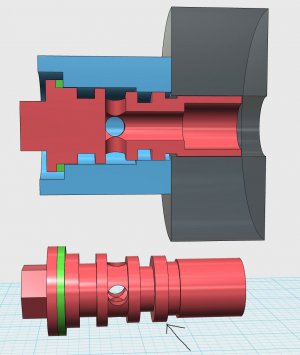I goofed. I did. I accidentally missed the length of the part shown in the picture. The dimension pointed to by the arrow is too short by 0.050". In the cross section, you can see the blue part in which the red part sits is 0.050" deeper than the red part, which I machined of brass. The shoulder on the brass piece should be flush with the bottom of the blue piece and bottom out on the gray piece. The green washer is made of plastic (nylon, I think), and is 0.060" thick. Replacing it with a nylon or teflon washer 0.010" thick would work, but I don't know where I could get a washer 5/8" ID x 3/4" OD x 0.010" thick. If someone knows where, I would appreciate knowing it. I could make a washer 0.433" ID x 0.550" OD x 0.050" out of brass (I think), but I am concerned about keeping it centered during assembly.
Any ideas?
Any ideas?



